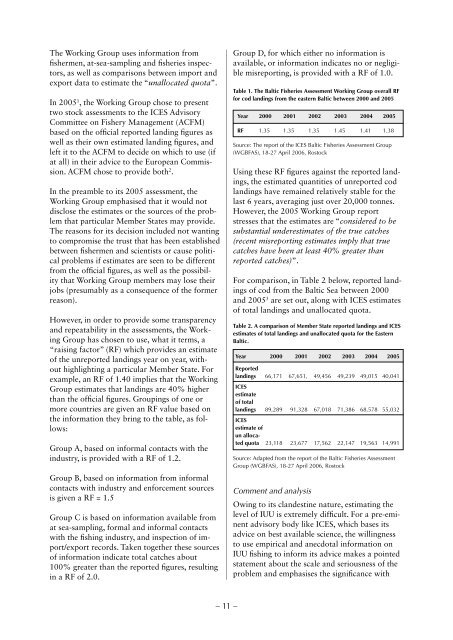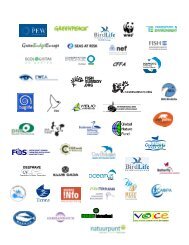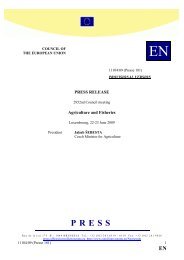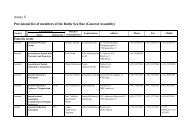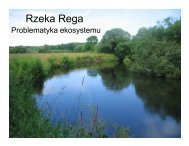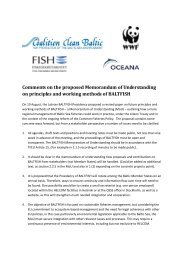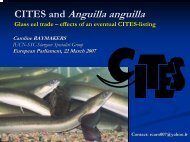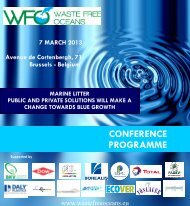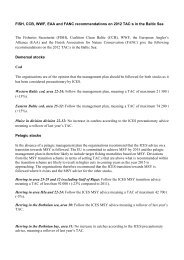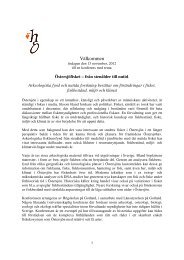A report on iUU fishing of Baltic Sea cod - Fisheries Secretariat
A report on iUU fishing of Baltic Sea cod - Fisheries Secretariat
A report on iUU fishing of Baltic Sea cod - Fisheries Secretariat
You also want an ePaper? Increase the reach of your titles
YUMPU automatically turns print PDFs into web optimized ePapers that Google loves.
The Working Group uses informati<strong>on</strong> fromfishermen, at-sea-sampling and fisheries inspectors,as well as comparis<strong>on</strong>s between import andexport data to estimate the “unallocated quota”.In 2005 1 , the Working Group chose to presenttwo stock assessments to the ICES AdvisoryCommittee <strong>on</strong> Fishery Management (ACFM)based <strong>on</strong> the <strong>of</strong>ficial <str<strong>on</strong>g>report</str<strong>on</strong>g>ed landing figures aswell as their own estimated landing figures, andleft it to the ACFM to decide <strong>on</strong> which to use (ifat all) in their advice to the European Commissi<strong>on</strong>.ACFM chose to provide both 2 .In the preamble to its 2005 assessment, theWorking Group emphasised that it would notdisclose the estimates or the sources <strong>of</strong> the problemthat particular Member States may provide.The reas<strong>on</strong>s for its decisi<strong>on</strong> included not wantingto compromise the trust that has been establishedbetween fishermen and scientists or cause politicalproblems if estimates are seen to be differentfrom the <strong>of</strong>ficial figures, as well as the possibilitythat Working Group members may lose theirjobs (presumably as a c<strong>on</strong>sequence <strong>of</strong> the formerreas<strong>on</strong>).However, in order to provide some transparencyand repeatability in the assessments, the WorkingGroup has chosen to use, what it terms, a“raising factor” (RF) which provides an estimate<strong>of</strong> the un<str<strong>on</strong>g>report</str<strong>on</strong>g>ed landings year <strong>on</strong> year, withouthighlighting a particular Member State. Forexample, an RF <strong>of</strong> 1.40 implies that the WorkingGroup estimates that landings are 40% higherthan the <strong>of</strong>ficial figures. Groupings <strong>of</strong> <strong>on</strong>e ormore countries are given an RF value based <strong>on</strong>the informati<strong>on</strong> they bring to the table, as follows:Group A, based <strong>on</strong> informal c<strong>on</strong>tacts with theindustry, is provided with a RF <strong>of</strong> 1.2.Group B, based <strong>on</strong> informati<strong>on</strong> from informalc<strong>on</strong>tacts with industry and enforcement sourcesis given a RF = 1.5Group C is based <strong>on</strong> informati<strong>on</strong> available fromat sea-sampling, formal and informal c<strong>on</strong>tactswith the <strong>fishing</strong> industry, and inspecti<strong>on</strong> <strong>of</strong> import/exportrecords. Taken together these sources<strong>of</strong> informati<strong>on</strong> indicate total catches about100% greater than the <str<strong>on</strong>g>report</str<strong>on</strong>g>ed figures, resultingin a RF <strong>of</strong> 2.0.Group D, for which either no informati<strong>on</strong> isavailable, or informati<strong>on</strong> indicates no or negligiblemis<str<strong>on</strong>g>report</str<strong>on</strong>g>ing, is provided with a RF <strong>of</strong> 1.0.Table 1. The <strong>Baltic</strong> <strong>Fisheries</strong> Assessment Working Group overall RFfor <strong>cod</strong> landings from the eastern <strong>Baltic</strong> between 2000 and 2005Year 2000 2001 2002 2003 2004 2005RF 1.35 1.35 1.35 1.45 1.41 1.38Source: The <str<strong>on</strong>g>report</str<strong>on</strong>g> <strong>of</strong> the ICES <strong>Baltic</strong> <strong>Fisheries</strong> Assessment Group(WGBFAS), 18-27 April 2006, RostockUsing these RF figures against the <str<strong>on</strong>g>report</str<strong>on</strong>g>ed landings,the estimated quantities <strong>of</strong> un<str<strong>on</strong>g>report</str<strong>on</strong>g>ed <strong>cod</strong>landings have remained relatively stable for thelast 6 years, averaging just over 20,000 t<strong>on</strong>nes.However, the 2005 Working Group <str<strong>on</strong>g>report</str<strong>on</strong>g>stresses that the estimates are “c<strong>on</strong>sidered to besubstantial underestimates <strong>of</strong> the true catches(recent mis<str<strong>on</strong>g>report</str<strong>on</strong>g>ing estimates imply that truecatches have been at least 40% greater than<str<strong>on</strong>g>report</str<strong>on</strong>g>ed catches)”.For comparis<strong>on</strong>, in Table 2 below, <str<strong>on</strong>g>report</str<strong>on</strong>g>ed landings<strong>of</strong> <strong>cod</strong> from the <strong>Baltic</strong> <strong>Sea</strong> between 2000and 2005 3 are set out, al<strong>on</strong>g with ICES estimates<strong>of</strong> total landings and unallocated quota.Table 2. A comparis<strong>on</strong> <strong>of</strong> Member State <str<strong>on</strong>g>report</str<strong>on</strong>g>ed landings and ICESestimates <strong>of</strong> total landings and unallocated quota for the Eastern<strong>Baltic</strong>.Year 2000 2001 2002 2003 2004 2005Reportedlandings 66,171 67,651, 49,456 49,239 49,015 40,041ICESestimate<strong>of</strong> totallandings 89,289 91,328 67,018 71,386 68,578 55,032ICESestimate <strong>of</strong>un allocatedquota 23,118 23,677 17,562 22,147 19,563 14,991Source: Adapted from the <str<strong>on</strong>g>report</str<strong>on</strong>g> <strong>of</strong> the <strong>Baltic</strong> <strong>Fisheries</strong> AssessmentGroup (WGBFAS), 18-27 April 2006, RostockComment and analysisOwing to its clandestine nature, estimating thelevel <strong>of</strong> IUU is extremely difficult. For a pre-eminentadvisory body like ICES, which bases itsadvice <strong>on</strong> best available science, the willingnessto use empirical and anecdotal informati<strong>on</strong> <strong>on</strong>IUU <strong>fishing</strong> to inform its advice makes a pointedstatement about the scale and seriousness <strong>of</strong> theproblem and emphasises the significance with– 11 –


